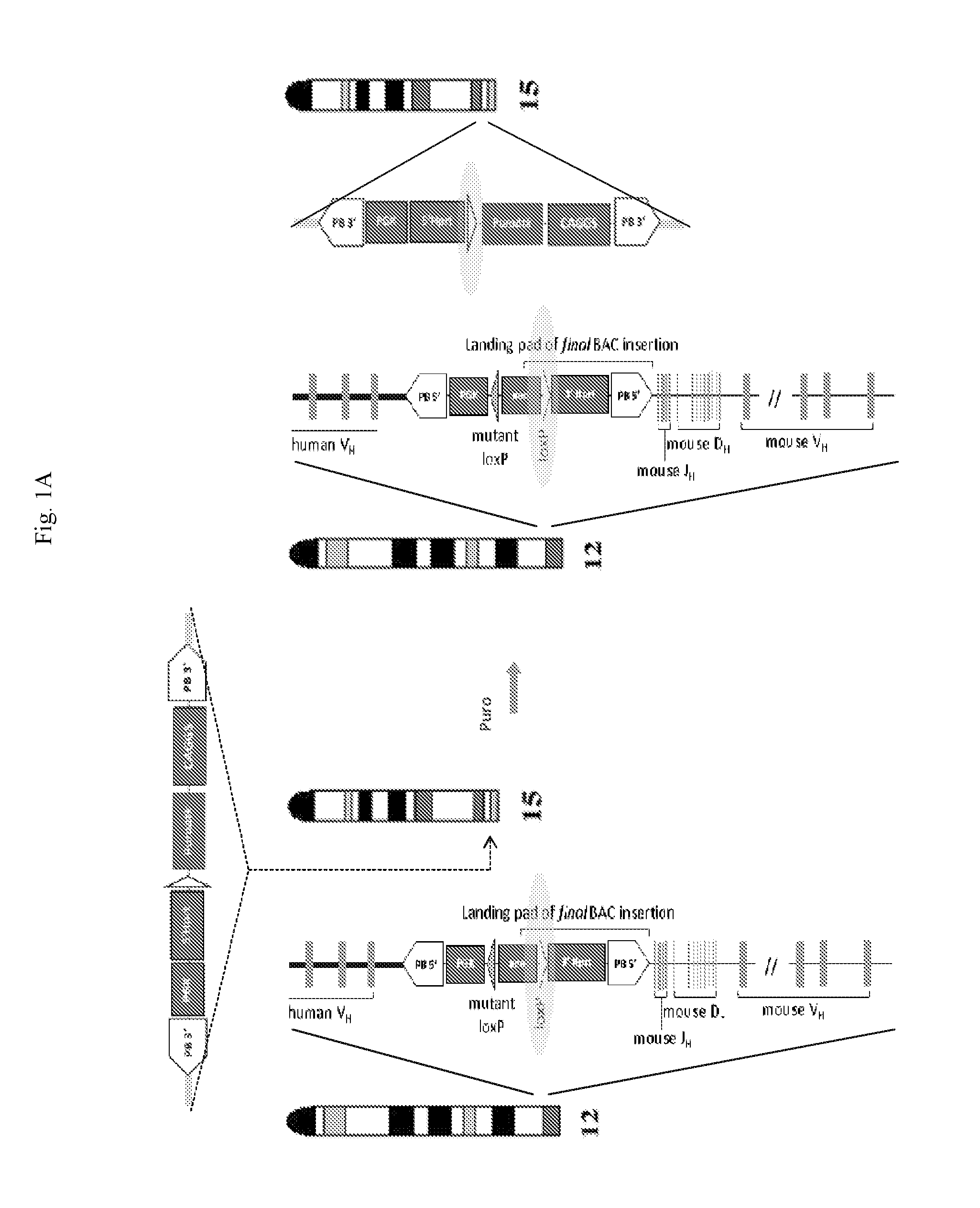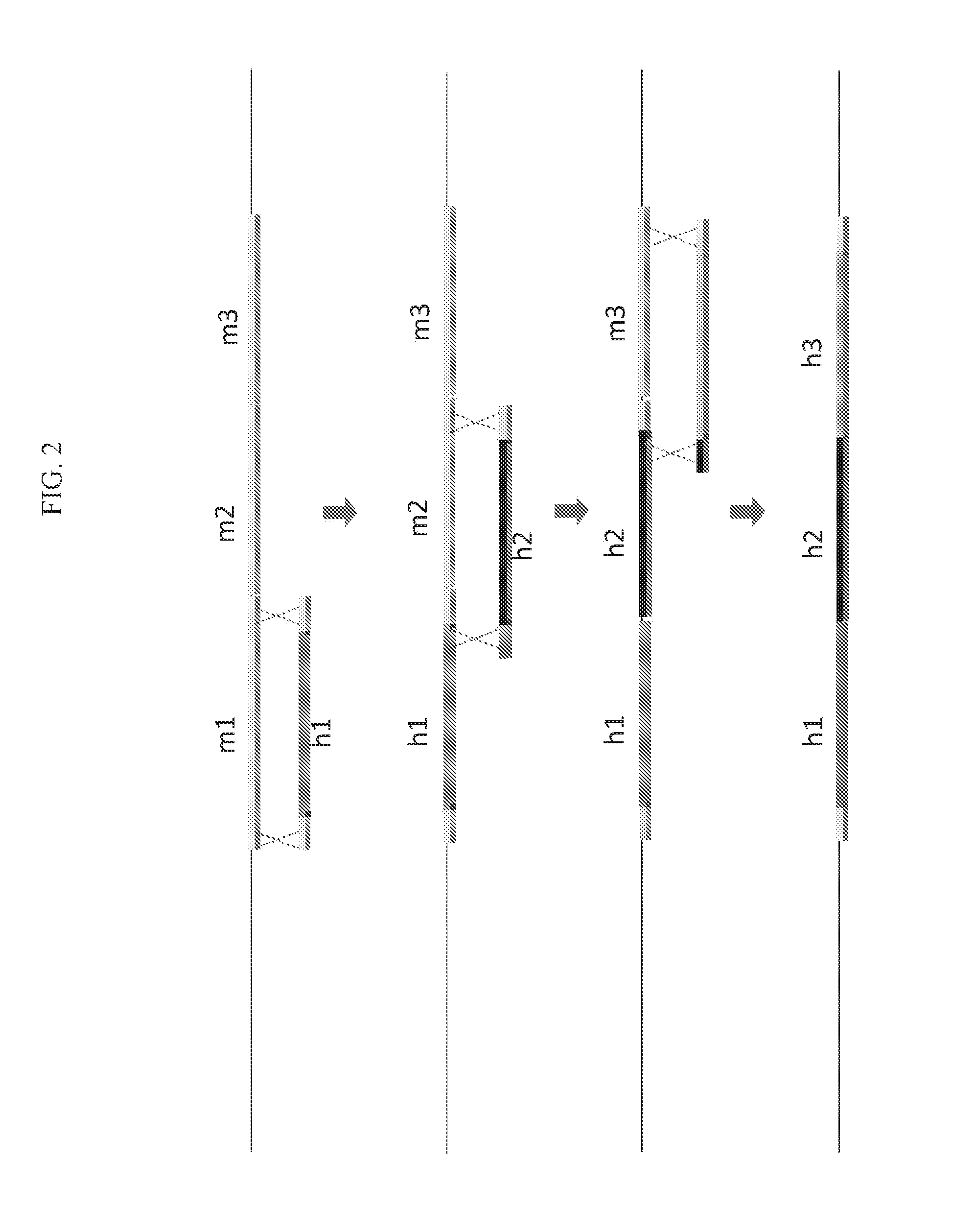Transgenic Animals
a technology of transgenic mice and a technology of enzymology, applied in the field of transgenic animals, can solve the problems of hammering the breeding of colonies and hampering the utility of such mice as transgenic antibody-generating platforms
- Summary
- Abstract
- Description
- Claims
- Application Information
AI Technical Summary
Benefits of technology
Problems solved by technology
Method used
Image
Examples
example 1
Translocation
[0185]Reference is made to FIG. 1a where chromosome 12 is shown harbouring a transgenic heavy chain locus. In the figure, the inserted human VH gene segments are shown (but for clarity the human D and JH, the mouse Emu enhancer and other J-C Intronic elements, and also the constant region are not shown, but these lie downstream of the human VH gene segments (ie, to the left of the VH). Also shown is a loxP site on chromosome 12 between the human VH and the mouse VDJ region (in this case the loxP being provided by a “landing pad”; see, eg, WO2011004192 the disclosure of which is incorporated herein by reference). A cassette, carrying a loxP site in the same direction to the ioxP site in the landing pad, is targeted at the telomere region of a different chromosome from chromosome 12; in this case targeting is to chromosome 15 as shown in FIG. 1a. A vector carrying a Cre recombinase gene is introduced into the cell. Following induction of Cre recombinase expression, the re...
example 2
Deletion & Insertion of Adam 6 Genes
[0186]Generation of Transgenic Antibody-Generating Mouse
[0187]A transgenic mouse is generated using ES cell technology and genetic manipulation to introduce human antibody heavy chain and kappa chain V, D and J segments operatively connected directly 5′ of endogenous mouse heavy and kappa constant regions respectively. Mouse mu switch and mu constant and gamma regions are provided in the heavy chain transgenic locus thus produced. Endogenous, mouse heavy chain and kappa chain expression are inactivated; mouse lambda chain expression is typically 5% or less so inactivation is optional. The human antibody gene segments are introduced into a mouse ES cell using homologous recombination and / or recombinase mediated cassette exchange (RMCE) as is known in the art. Human DNA can be manipulated using BAC and recombineering technology as known in the art. BACs containing human antibody gene DNA is obtainable from Invitrogen. A suitable ES cell is a 129, AB...
example 3
Approaches to Insert Adam6 Genes into Genome after Endogenous IgH Deletion
[0194]The mouse Adam6a (Chromosome 12: coordinates 114777119-114789625) and Adam6b (Chromosome 12: coordinates 114722756-114735229) genomic DNA is retrieved from a bacterial artificial chromosome (BAC), RP23-393F3 (Invitrogen). The ES-cell targeting vector is generated by the following steps.[0195]1. The sequence between mouse Adam6a and Adam6b is deleted by a positive selection marker cassette.[0196]a. 5′ arm which is located at ˜5 kb upstream of Adam6a and 3′ arm which is located at ˜5 kb downstream of Adam6b gene are created by PCR using RP23-393F3 as a template. Both homology arms are between 200 bp to 300 bp, then the two homology arms are cloned into a plasmid based on pBlueScript II SK(+) and that contains a positive selection marker Blasticidin (Bsd) which flanked by two Ascl sites, to build a deletion vector (FIGS. 4a and 4b).[0197]5′ Arm:
5′-tatgttgatggatttccatatattaaaccatccctgcatccctgggatgaagcctacttg...
PUM
| Property | Measurement | Unit |
|---|---|---|
| adhesion | aaaaa | aaaaa |
| stability | aaaaa | aaaaa |
| compatibility | aaaaa | aaaaa |
Abstract
Description
Claims
Application Information
 Login to View More
Login to View More - R&D
- Intellectual Property
- Life Sciences
- Materials
- Tech Scout
- Unparalleled Data Quality
- Higher Quality Content
- 60% Fewer Hallucinations
Browse by: Latest US Patents, China's latest patents, Technical Efficacy Thesaurus, Application Domain, Technology Topic, Popular Technical Reports.
© 2025 PatSnap. All rights reserved.Legal|Privacy policy|Modern Slavery Act Transparency Statement|Sitemap|About US| Contact US: help@patsnap.com



